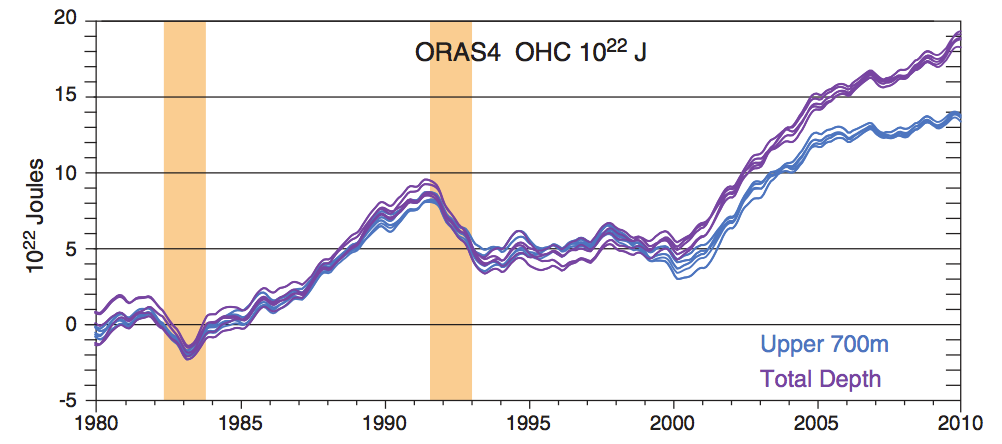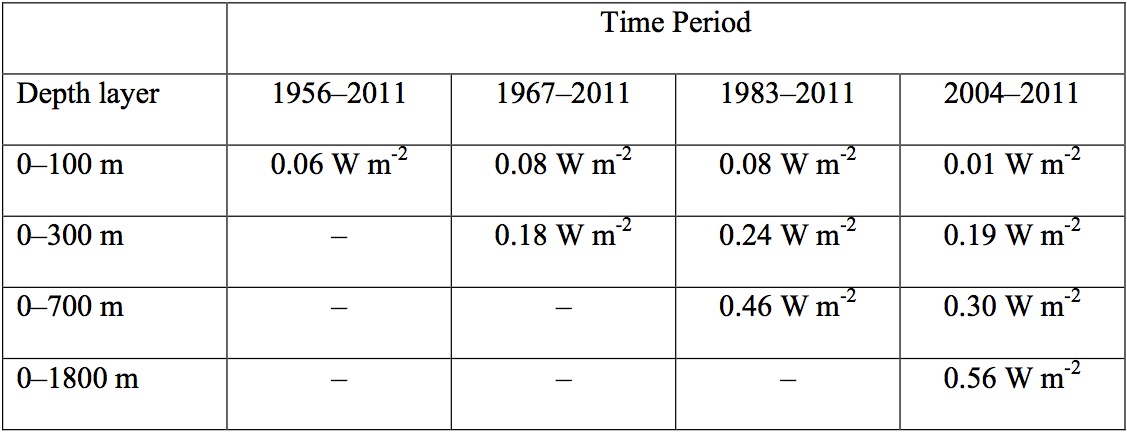Key Points:
- The ocean is quickly accumulating heat and is doing so at an increased rate at depth during the so-called “hiatus” – a period over the last 16 years during which average global surface temperatures have risen at a slower rate than previous years.
- This continued accumulation of heat is apparent in ocean temperature observations, as well as reanalysis and modeling experiments, and is now supported by up-to-date assessments of Earth's energy imbalance.
- Another key piece of evidence is rising global sea level. The expansion of the oceans (as they warm) has contributed to 35–40% of sea level rise over the last two decades – providing independent corroboration of the increase in ocean temperatures.
The Deep Ocean Layers Are Quickly Accumulating Heat
Recently there have been some widespread misconceptions about heat accumulation in the oceans, particularly in the deeper layers below 700 meters. Balmaseda et al. (2013) was a key study on this subject, using ocean heat content data from the European Centre for Medium-Range Weather Forecasts' Ocean Reanalysis System 4 (ORAS4). (A ‘reanalysis’ is a climate or weather model simulation of the past that incorporates data from historical observations. In the case of ORAS4, this includes ocean temperature measurements from bathythermographs and the Argo buoys, and other types of data as for example, sea surface height and surface temperatures.) Their study concluded that heat has increased in the deep oceans at an unprecedented rate in recent years, with approximately 30% being sequestered below 700 meters since the year 2000.
The five ensemble members of the ORAS4 ocean reanalysis OHC for 0–700 m and full-depth ocean are shown, where they have been aligned for 1980 to 1985, in 1022 J. The increased heating below 700 m of about 0.2 W/m2 globally is revealed after about 2000. The orange bars show the times of the El Chichón and Pinatubo volcanic eruptions. From Trenberth and Fasullo (2013).
The increase in deep ocean heat content is also a robust result in data sets that do not include reanalysis. For example, as discussed in Nuccitelli et al. (2012), the ocean heat content data set compiled by a National Oceanographic Data Center (NODC) team led by Sydney Levitus shows that over the past decade, approximately 30% of ocean heat absorption has occurred in the deeper ocean layers, consistent with the results of Balmaseda et al. (2013).
Land, atmosphere, and ice heating (red), 0-700 meter OHC increase (light blue), 700-2,000 meter OHC increase (dark blue). From Nuccitelli et al. (2012)
Similarly, a new paper by Lyman and Johnson (2013) concludes,
"In recent years, from 2004 to 2011, while the upper ocean is not warming, the ocean continues to absorb heat at depth (e.g., Levitus et al., 2012; von Schuckman & Le Traon, 2011), here estimated at a rate of 0.56 W m-2 when integrating over 0–1800 m."
The paper also includes this useful table illustrating that according to observational data, ocean heat content has indeed accumulated rapidly in the deep oceans in recent years. Of the heat accumulating in the upper 1,800 meters of oceans for 2004–2011, 46% was sequestered in the deep oceans (below 700 meters) in the Lyman and Johnson data set.
For 2004–2011, they find the oceans accumulating 0.56 W/m2 (9 x 1021 J/yr) in the upper 1,800 meters – equivalent to 4.5 Hiroshima atomic bomb detonations per second – during a time when many have argued that global warming has magically "paused."
There are some differences among these studies, although all agree that the deep ocean is taking up more heat recently. The differences arise from how gaps in observations are filled in time and space, and the reanalyses do this most comprehensively by utilizing all kinds of data as well as using ocean models to span gaps.
Ocean Heat Accumulation Consistent with Other Observations
We also know from satellite observations that the planet is accumulating heat owing to a global energy imbalance. A new paper by Trenberth et al. (2014) notes that the amount of heat accumulating in the global climate (most of which is absorbed by the oceans) is generally consistent with the observed global energy imbalance.
Due to the increased greenhouse effect 'trapping' more heat, there is more incoming than outgoing energy at the top of the Earth's atmosphere. That energy has to go somewhere. With over 90% being absorbed by the oceans, we fully expect the oceans to do exactly what they are doing – accumulate a whole lot of energy. What's more, continually increasing greenhouse gases increase the imbalance by about 0.3 W/m2 per decade even as the planet warms and radiates some extra heat back to space. If global warming were to "pause," it would require an explanation of where the energy from the global imbalance is going.
There is also the issue of sea level rise, whose main contributors are melting glaciers and ice sheets, and thermal expansion (water expanding as it warms). Climate scientists have been able to close the sea level "budget" by accounting for the various factors that are causing average global sea levels to rise at the measure rate of about 3.2 millimeters per year since 1992 (when altimeters were launched into space to truly measure global sea level). The warming oceans account for about 35–40% of that rate of sea level rise over the past two decades, according to the IPCC AR5. If the oceans weren't continuing to accumulate heat, sea levels would not be rising nearly as fast.
The "Pause" is a Fiction; Ocean Warming is Factual
The bottom line is that all available information related to ocean heat content shows that the oceans and global climate continue to build up heat at a rapid pace, consistent with the global energy imbalance observed by satellites and the rate of global sea level rise. In recent years, about one-third of that heat has accumulated in the deep oceans.
While the rate of increase of global surface temperatures in recent years has slowed in large part due to the more efficient heat transfer to the deep oceans, that can't last forever. A key reason is that sea level rise occurs unevenly, and in some places, such as near the Philippines, sea level has risen over 20 cm since 1992, while in other places it has fallen slightly. In particular, the slope of the ocean surface across the Pacific has increased by 20 cm, and the water wants to slosh back but is prevented by stronger easterly trade winds. The resulting changes in ocean currents are part of the reason why more heat has gone deeper.
When that trend reverses, as past observations suggest it will (likely within the next decade, according to Trenberth and Fasullo [2013]), we'll experience an acceleration in warming at the Earth's surface.










No comments:
Post a Comment